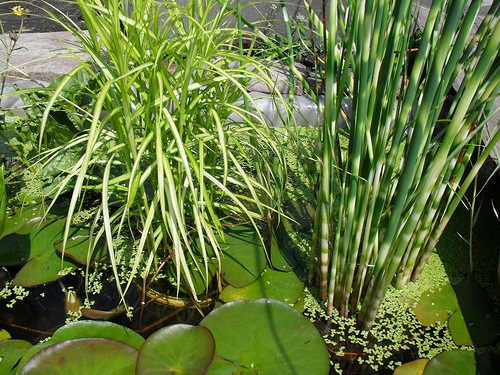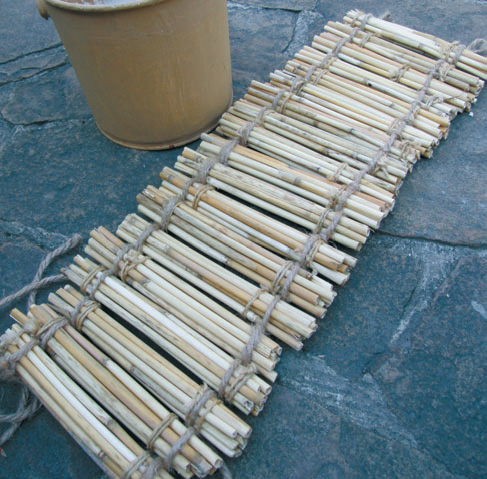Artificial reservoirs are at many cottages and almost every cottage owner. It's beautiful. And how nice to sit in the evening near the lake, admire the fish, on beautiful aquatic plants. To decorate the reservoir, created by your own a piece of wildlife - small thickets of the reed. On the landing and growing of the reasons in his site is told in this article.
Content
Types of Kamyshem
Rocket and Rogoz are often confused. Three main types of reasons are:
- plant having long, up to 2.5 m stems, with a dense inflorescence with a height of up to 10 cm, in the form of one or more spikelets, is called reed lake. Rhizome is hollow, twisted;
- reeds with a triangular stem, growing up to 1 m, with long rough leaves, crowned in the middle of summer with greenish pancake, are called forest. Judging by the title, it can be assumed that it grows in the forest, but in fact in the forest most often it is possible to meet it very rarely. In large quantities it grows on the swamp, it creates thickets on wet banks of rivers and lakes;
- from the tropics came to us replays drooping. It is also grown in the room. His stems are thin and elegant, like hair, and the flowers are so small, which can not be noticed. If the temperature drops below +12 degrees with, it is already necessary to put it in heat, otherwise it will be lost. In the spring, he will bloom in the room: small brown spikes will appear, which are closer to the summer turn into white tiny guns.
Special attention deserves reed lake. There are such varieties:
- green in summer and bright yellow in spring Golden Spears (Golden Spears);
- allocated among juicy greenery
- plant with horizontal yellow stripes on green stems is Zebrinus (zebrinus). The variety is the most decorative. Like all kinds of the root, perfectly cleans the water. Here it is in the photo on the right:
Growing Kamyshem
There should be no difficulty in growing a canthammer, it is much more difficult to regulate its quantity: it creates very quickly.
The most suitable soil
Even this is not a particularly capricious plant as reed, there are their preferences. He loves:
- neutral sooth or weakness;
- sunlights. In addition to the reinforcement reinforcement - it does not tolerate direct sunlight, and it grows well in the shade;
- not just moisture, but even swamp. It grows and in water, where the depth reaches 0.3 m.
How to plant reed
In the country, the reed lake most often. Landing is not much different from landing other aquatic plants:
- before planted reed, prepare deep tanks with a diameter of at least 15 o mm;
- at the bottom, we definitely place drainage;
- mix the peat and the ground from the compost heap. We place this mixture over drainage;
- sadim rhizome reasons and pour well;
- laying on top of pebbles or crushed stone. Carefully omit on the bottom.
How to multiply
Modify the reed simply:
- if you once planted it, you will multiply, sharing the rhizome in the fall or with the onset of spring. This fully refers to the varietal species of the root, and the wild multiplies with seeds. At the same time, it should be borne in mind that Kamysh is in nature - aggressor;
- having landed the reed on the shore of the reservoir without a container, we continue themselves to be a serious struggle with him, and otherwise he will ous out all the other plants.
How to care
Reason is not demanding and care for it is:
- in preventing growth;
- timely division of rhizomes;
- checking adjacent containers with other plants. There may well be the creeping root of the cantham;
- in the heat it is helpful to spray the leaves.
Among the unpretentious species of this plant there are one non-wellhead: a decomposition of reservoir care is required.
- it can be visited by the wave and tick of the web, then they will have to go into the course of special insecticides;
- passionate fans of rebuilding are cats. So they love him that in the literal sense is ready to eat. So, if for the winter you brought a pot into the room, you will have to take any security measures;
- if the turning reed does not transplant in the spring annually, he will also play;
- when placing a container with it on an outdoor sunny section, it will not grow: yellowes, and then dry at all;
- starting from March and throughout the summer, it is fettered by fertilizers;
- it is better to reproduce it with seeds, then it turns out to be stronger. Having gathered from the spikelets of the seeds, they are sown in the mixture, as for fern: peat, earth, large sand. The dishes are placed in the pallet with water, and then the seedlings of the seedlings are placed on individual pots;
- do not forget about humidity. For good development, it must be maintained at no less than 50%. While he grows in the garden pond, this condition is not difficult to observe, but in the winter it will help spraying every day. His extraordinary beauty is these works.
Interesting: It is believed that the turning reed favorably affects representatives of such signs of the zodiac as crayfish, scorpions and fish, i.e. Water.
Decor from Koman
If your reed is growing on the plot, then you have excellent natural material for the decor. A special charm will give the dacha rug woven from the lake cant. It is this kind of rebel that is most suitable for weaving: 
But how it is done:
Reeds can decorate a flower pot: 
Consider the manufacture of this decorative element from the reasons for your garden somewhat more details:
- take dry stalks of the reed;
- rope, better hemp;
- do not do without a secaterator;
- some suitable containers, for example: out of paint;
- paint and brush.
That's all, you can proceed:
- stems cut into segments whose length is somewhat exceeds the height of the tank;
- we associate the stalks in the dogs, the pieces of 8 approximately;
- cutting the rope with such a calculation to cover the future vancing of 4. Yes, folding it in half, we associate ends;
- in the resulting ring insert the cantshams and spinning and rope. We do the same with the following stranges. As a result, a mat should be like, but it is still connected only from one end, so we cut a piece of rope of the same length and repeat the operation from the opposite end;
- capacity, paints and dry;
- our product is wrapped around the bank and tie the ends.
This wonderful box is made of the lake root:
Wonderful and unusually looks like the most ordinary fence from the chain grid, if it is decorated with reed:
There are many interesting ideas for the use of the root. Here is one of them:


























